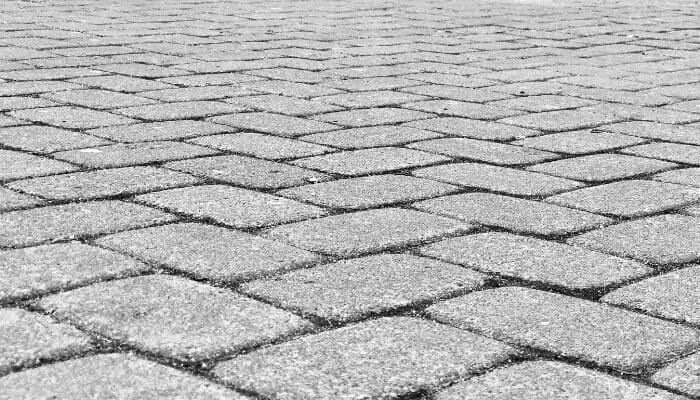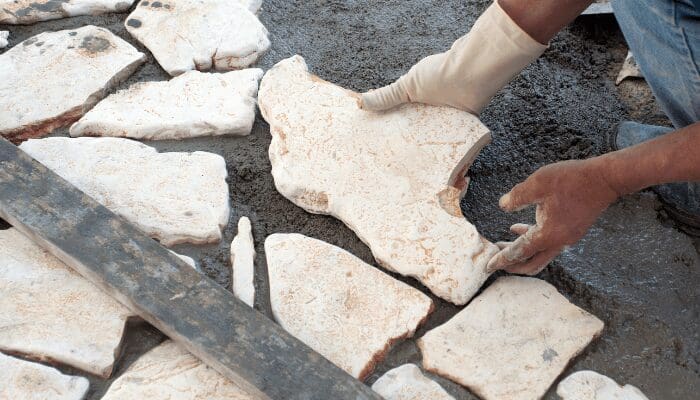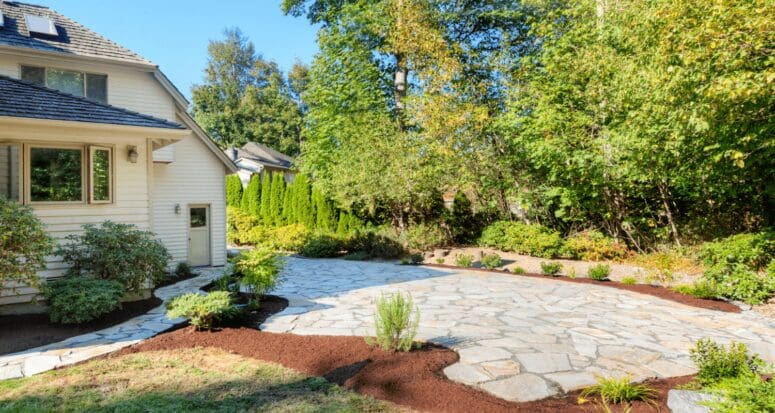Do Certain Projects Using Pavers Increase Home Value?
- Published on
- 4-5 min read
-
 Catherine Conelly Contributing AuthorClose
Catherine Conelly Contributing AuthorClose Catherine Conelly Contributing Author
Catherine Conelly Contributing AuthorCatherine has 8 years of experience as a writer and editor. Her work can be seen in PopSugar, Thrillist, Shape, and SheKnows. She holds a Bachelor's Degree in Creative Writing from Arizona State University and currently resides in Arizona.
According to the International Concrete Paver Institute’s annual report, more than 750 million square feet of concrete pavers were sold in the U.S. and Canada in 2018, and nearly 78% of that went toward residential projects. So, what’s all the rave about pavers?
In a nutshell, they’re versatile and add functionality to outdoor spaces. Nicole Cook, a landscape architect of 11 years who owns her own business in California, describes them as flat materials used for exterior flooring. So simple, but pavers easily transform just about any corner of your yard and put an end to drab curb appeal.
As for whether pavers actually increase home value, it’s not the pavers themselves that matter. It’s what they create; their sum is greater than their parts. Invest in the wrong paver project and you could be throwing money out the door. You may want to revamp your driveway or build a retaining wall for your garden, but these projects may not be necessary to sell your home.

So, do pavers add value or not? There are a couple ways to look at it.
“[Pavers are] more of a nice-to-have than a must-have to get maximum value,” says Anthony Navarro, a real estate agent in San Francisco who performs in the top 1% of realtors internationally.
For example, San Francisco is a competitive market, so buyers are more willing to overlook certain scars that a structure may have. He recalls a recent sale where the house had a cracked driveway and still received offers $300,000 over asking price. The buyer could have added a new paver driveway, but it wouldn’t have been necessary.
In another market or for a different house that lacked other selling points, fixing the driveway may have been a smart investment. That’s why it’s important to have an informed local real estate agent to guide you through your options and the potential outcomes.
On another hand, a paver driveway may appeal to younger buyers who value sustainability.
“Pavers can be used to create a more sustainable, permeable driveway,” says Cook, pointing out that it keeps rainwater from washing into the road and allowing it to soak into the ground instead. “I would suggest a concrete option over natural brick or stone.”
While not every paver project has a cha-ching effect on your home’s value, there is a case to be made for them. They do create a certain upscale ambiance, and the right vibe makes buyers feel at home.
Consider these scenarios:
When pavers give you a patio:
The National Association of Realtors surveyed homeowners, landscape professionals, and Realtors to evaluate how certain outdoor remodels contributed to resale. Upgraded hardscape and landscape design both placed in the top four projects that buyers find appealing and that Realtors agree can add resale value. With that in mind, a simple paver patio may be just what your backyard needs. Keyword: simple. Don’t get fancy and your ROI won’t be in jeopardy.
According to Remodeling Magazine’s 2019 Cost vs. Value report, an elaborate backyard patio only recoups about half of the cost. So skip the expensive flagstone, custom fire pit, new sliding glass door, outdoor seating, outdoor kitchen, and outdoor lighting.
Data from HomeLight’s Top Agent Insights Survey, on the other hand, showed that on a mid-scale patio where you spend an average $3,269, you’d get a $3,563 back at resale for a 9% ROI. Add a simple fire pit, something millennials appreciate more than a pool, but there’s no need to pay for anything overly customized.

When pavers revive your curb appeal:
Curb appeal is a no brainer. HomeLight data shows 76% of agents felt curb appeal was the No. 1 thing you can do to make your home more appealing to buyers.
“Curb appeal is important for a home,” says Navarro. “It’s our first impression for a buyer.” But it’s not just cutting the bushes and mowing the grass (though those make a big difference). A simple walkway adds character and functionality. “Pavers are a good option for that,” he says.
According to the NAR, adding a walkway with a couple planters and handful of shrubs recoups more than 80% of the value. Out of the 27% of Realtors who reported completing a landscape update before listing a property, 11% said it helped them seal the deal.
All in all, when you need to improve curb appeal or create outdoor living space where there isn’t any, pavers are a practical option. They are more attractive than a rock path and help to create functional spaces with minimal materials. Just take a minimalist approach to make sure your project adds value.
When pavers improve the flow of indoor outdoor living:
Flow is everything. “It’s all about how the buyer feels when they walk into the house and then how they feel when they’re going to the backyard and how it flows from a living room or dining room,” says Navarro.
Even if your home has a patio currently, does it allow for adequate outdoor living? Is there enough space for a table that guests can gather around? What about lounge chairs? Or is your hardscape too big and awkwardly takes over the yard?
In that case you may want to remove sections and revamp the portion you’re going to keep. “Balance is always preferred and there are always ways to soften the hardscape with plant materials,” says Cook.
With these recommendations in mind, here are 3 paver projects worth your time and money:
1. Build a simple patio to extend your outdoor living space.
Depending on the size of the patio your yard needs, it may be worth it to hire a professional. It’s a tedious job to lay pavers. That said, it’s not impossible to DIY a small area. “If homeowners have the time and are good at following the process, it can be done,” Cook says. “My suggestions would be to make sure the area is graded and level and that the base has been applied evenly and compacted.”
You can also find a detailed tutorial here, courtesy of Oregon State University’s extended education service on gardening and landscaping. It breaks down each and every detail. Here are the highlights:
- If there isn’t an existing area, you’ll need to dig down about 8 inches for the entire area.
- You’ll need a 4-inch compacted base.
- A layer of sand covers your base. Make sure your base begins to grade away from the house.
- Once pavers are laid, top with more sand to fill in the cracks, and sweep.
- Other tools you’ll need include a tamper, edge restraints, and sealant.
2. Add an inviting walkway.
Literally welcome buyers with a walkway. To DIY a paver walkway, follow the same instructions above. But first, choose your materials wisely. There are several types of pavers: stone (this includes cobblestone, flagstone, and travertine), concrete, or brick. Stone is more expensive; concrete or brick pavers will keep costs down. But if the area is small and your home is in a high-end area, it might make sense to spring for natural stone.
3. Refresh your pool deck.
If you already have a functioning patio, but your pool deck looks worn and faded like an old t-shirt, than it may be an eyesore to buyers on an otherwise inviting backyard. Pavers are an option. “The majority of exterior pavers are slip-resistant,” Cook says. And pavers are more affordable compared to concrete, according to HomeAdvisor, sitting in at $3 to $7 per square foot.

No matter your project, choose materials wisely
Style matters. You don’t want a contemporary-looking patio in the backyard of a traditional home. “Brick [pavers] tends to pair well with traditional design and architecture,” says Cook. For a more contemporary and modern look, concrete pavers may play to that strength.
Meanwhile, Cooks says natural stone pavers are a happy medium, usually a fit for either end of the spectrum. “They all are quite durable and installed the same way, that’s why the choice usually comes down to budget and design,” she says. Natural stone is also the more affordable of the bunch, according to HomeAdvisor. So when it comes to updating a space before you sell, that’s the most cost effective choice. But remember, pavers aren’t a must.
Don’t rule out other materials such as fine gravel or decomposed granite if you live in a climate with minimal rain. According to Cook, those are affordable options for creating a space for tables and chairs. And in some cases, pouring cement may be an option as well. Contrary to popular belief, it can be done with style, as seen in one of her projects here. “There are ways to arrange the joints to reflect other parts of the design,” she says. “It can also be tinted, stained or stamped.”
Above all, if you want to maximize ROI, don’t splurge on materials and consult with a landscape expert in your area as well as your local agent for advice. If your agent doesn’t feel you should spend over a certain amount but agrees the patio or walkway needs work, weigh your options with the pros.
Header Image Source: (Jo Ann Snover/ Shutterstock)
